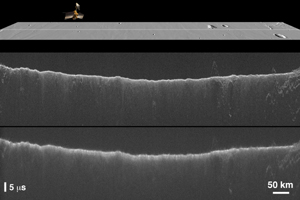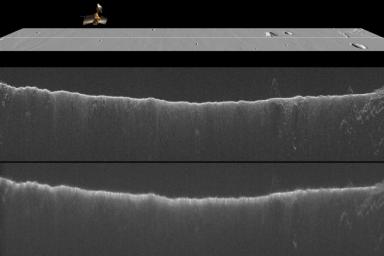
Figure 1
Click on the image for larger versionA comparison of two radargrams from the Shallow Radar (SHARAD) instrument on NASA's Mars Reconnaissance Orbiter shows effects on the Martian ionosphere from the passage of comet C/2013 A1 Siding Spring close to Mars.
The top graphic depicts the orbiter and the ground track (white line) of a flight over part of the Solis Planum region of Mars, shown on a shaded rendition of the local topography. The middle portion presents SHARAD data acquired under normal nighttime conditions as the orbiter flew that track in October 2013. The bottom portion presents SHARAD data acquired on Oct. 19, 2014, 2.5 hours after the closest approach to Mars by the comet.
The data acquired after the passage of the comet show a blurring effect induced by the passage of the radar signals through an ionized layer. This layer was apparently generated by impacts of debris from the comet into the upper atmosphere of Mars -- essentially a meteor shower.
Both observations were taken on the night side of Mars at a local time of about 3 a.m. Normally no correction for the ionosphere is needed at this time of night. However, after the passage of comet Siding Spring, the night side developed a never-before-seen ionized layer.
Correcting for the smear of the surface echo allows calculating the density of the ionosphere above that location. For the Oct. 19, 2014, SHARAD observation, the measured ionosphere, in terms of "total electron content," (TEC) is five to 10 times that which is typically observed at those times of night. TEC is a basic characterization of the ionosphere giving the total number of electrons in a one-meter squared column between the spacecraft and the surface of Mars. The observed TEC values are typical for daylight hours just after dawn or before sunset, but are unprecedented for this deep into the night.
Figure 1 is a version with labels.
Location of the ground track is 25 degrees south latitude, 270 degrees east longitude. Image width is 570 miles (920 kilometers). Subsurface radar reflections are not commonly observed in this region of Mars, and none are apparent in these data.
SHARAD was provided by the Italian Space Agency. Its operations are led by Sapienza University of Rome, and its data are analyzed by a joint U.S.-Italian science team. NASA's Jet Propulsion Laboratory, a division of the California Institute of Technology in Pasadena, manages the Mars Reconnaissance Orbiter for the NASA Science Mission Directorate, Washington.

 Planetary Data System
Planetary Data System













